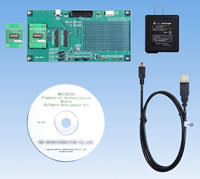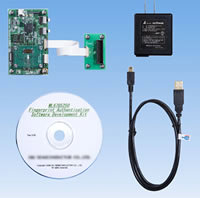2009 News Release
July 28, 2009
Oki Semiconductor starts high volume production of a postage stamp-sized compact fingerprint authentication module MK67Q5250
- Also releasing a fingerprint authentication LSI software development kit compatible with the new AuthenTec sensor for enriched total fingerprint authentication solution -
Oki Semiconductor has begun high volume production of the MK67Q5250, a compact fingerprint authentication moduleNote 1 based on the ML67Q5250, that includes all of the elements required for fingerprint authentication, including a fingerprint sensor and Oki’s fingerprint authentication LSI. The module is as small as a postage stamp (25.4 mm x 22.86 mm). It utilizes Oki Semiconductor’s fingerprint authentication LSI, the ML67Q5250, now in high volume production and a fingerprint sensor made by AuthenTec, one of the world' s top fingerprint sensor vendors. This module independently implements functions such as fingerprint data registration, authentication, and data management, which makes it easier to add fingerprint authentication system to any new or existing system.
Oki Semiconductor has also begun offering the fingerprint authentication LSI ML67Q5250 software development kit (SDK)Note 2 Version 4, which has been improved to support AuthenTec's new, low-power AES1711 slide sensorNote 3. Support of the new sensor makes a substantial reduction in standby power possible, enabling incorporation of fingerprint authentication into battery-powered equipment without the need for a switch. The maximum number of fingers registered in the built-in flash memory has been increased from 15 to 45, and a firmware update function has been added. These enhancements improve ease of integration and use of the SDK.
Development background
Oki Semiconductor developed the ML67Q5250, an LSI that implements fingerprint authentication processing (registration, authentication, and registration data management) in one-chip, which has been evaluated and adopted by many customers. Before the availability of this module adding fingerprint authentication to an existing product required design and procurement of hardware, development of software around the fingerprint sensor and processing engine as well as the development of a new board. Use of the Oki Semiconductor’s module allows designers to add the module and interact with it over a simple physical and logical interface with little impact to the existing system. To meet the demand to add fingerprint authentication, Oki Semiconductor has developed and initiated high-volume production of the ultra compact, postage stamp-sized MK67Q5250.
For those customers who want to use the module, but want to modify the existing software on the module, a optimized Module-SDK is also available.
To support complete designs based on the ML67Q5250 the ML67Q5250-SDK is available. The SDK is a reference HW and SW platform that designers can use to start developing and prototyping their designs. The V4.0 release of the SDK is targeted to address the ever increasing demand for standby current reduction. Specifically to demonstrate how to make it easy to add fingerprint based biometrics to battery-powered products, such as network tokens and door locks. For this purpose, the sensor on the SDK was upgraded to support the new AuthenTec AES1711 swipe sensor, which uses standby current in the microampere range. This makes it possible for the fingerprint authentication function to be added to battery-powered equipment without the need for a physical switch.
The new SDK also addresses the demand for a greater number of fingers to be registered in multi-user authentication systems. The SDK Version 4 allows an increased number of fingers to be registered in the built-in flash memory, raising the number to 45 without the need for external parts. This enables you to build an authentication system for a small office using only this LSI and fingerprint sensor.
Oki Semiconductor will continue to expand its fingerprint authentication solution lineup and develop attractive products that fit customer needs.
Fingerprint authentication module MK67Q5250 features
- Features
- All necessary fingerprint authentication functions implemented on a compact, postage stamp-sized board
- Outer dimensions
- Screw-fastened type: 25.4mm x 36.86mm x 4.0mm
Set-in type: 25.4mm x 22.86mm x 4.0mm
- AuthenTec AES2510 slide sensor
- High-performance fingerprint authentication processing
- DFT methodNote 4 (by Precise Biometrics) fingerprint authentication algorithm adopted High-speed authentication time: within 0.8 seconds (one-on-one authentication) High authentication accuracy: FARNote 5 (false acceptance rate) < 0.001%, FRRNote 6 (false rejection rate) < 1.0%
- Number of fingers registerable in the built-in flash memory: 15 (standard), to be expanded to 45 (September 2009)
- Security function which prohibits illegal fingerprint data reading
- Wide variety of external interfaces
- USB, SPI, UART, Smartcard I/F, GPIO
- Two power supply types; 5V and 3.3V single power supplies
- Shipment scheduled for October 2009
- Sample price (reference): 9,000 yen
- All necessary fingerprint authentication functions implemented on a compact, postage stamp-sized board
Module development SDK features

- Features
- Fingerprint authentication basic software controllable at the command level via SPI communication and USB communication Fingerprint image captured by AuthenTec sensor AES2510 Fingerprint template data generation and registration/ deletion in the built-in flash memory Fingerprint verification against registration data
- Power management control software for reduced module power consumption
- JTAG debug environment
- USB-based built-in flash rewrite software
- Fingerprint authentication demonstration function
- Shipment started in July 2009
- Reference price: 60,000 yen
- Module development SDK configuration
- MK67Q5250 Interface Board
- MK67Q5250 fingerprint authentication module sample
- CD-ROM (a suite of software)
- Sensor driver
- Fingerprint authentication engine
- Sample program and Windows application for fingerprint authentication demonstrations
- Various documents
Added functions to in SDK Version 4

- Added functions
- Support for AuthenTec sensor AES1711 Substantial reduction in standby current Fingerprint sensor placeable on the surface of chassis with sensor surface hard coating
- Number of fingerprint data items registerable in built-in flash increased to 45 (15 in SDK Version 3)
- Shipment scheduled for August 2009
- Reference price: 60,000 yen
- Configuration
- ML67Q5250 CPU board (7seg display, debug SRAM, switch)
- AES1711 sensor board (AuthenTec slide sensor)
- CD-ROM (a suite of software)
- Sensor driver
- Fingerprint authentication engine
- Sample program and Windows application for fingerprint authentication demonstrations
- Various documents
Notes on the module development SDK and SDK Version 4
* The compiler RealView Development Suit (RVDS) or ARM Developer Suite (ADS) needs to be prepared separately.
* The ARM7TDMI CPU compatible JTAG-ICE interface for software debugging needs to be prepared separately.
* Fingerprint sensor and its software driver are provided by the sensor manufacturer.
Glossary
- Note1: Fingerprint authentication module
- Small PCB board that has an AuthenTec slide sensor, crystal oscillator, regulator, and connectors on-board together with an LSI. Fingerprint data can be registered and authenticated on this board. Authentication results are read via connector.
- Note 2: SDK: Software Development Kit
- A collection of the development board, sample programs, drivers, and various documents for customers to develop a program.
- Note 3: Slide sensor
- A type of fingerprint sensor that captures a sliding fingerprint image. It is widely adopted in laptops, cell-phones, and so on.
- Note 4: DFT method
- DFT stands for Discrete Fourier Transform. One fingerprint authentication algorithm. It is also called "the frequency analysis method." It converts fingerprint contours to waveform data for verification. Compared with the major minutia and pattern matching methods, the rate of registration rejection due to fingerprint shape or dryness and roughness of the hand skin is extremely low.
- Note 5: FAR
- FAR stands for False Acceptance Rate. Error rate in which someone is accepted who should not be.
- Note 6: FRR
- FRR stands for False Rejection Rate. Error rate in which a user is rejected who should be approved.
* For details of AuthenTec fingerprint sensors, visit the AuthenTec Web site.
* For Precise Biometrics, visit the Precise Biometrics Web site.
* The names of companies and products are the trademarks or registered trademarks of the respective companies and organizations.
Contact
For customers' inquiry regarding this release: please go to ![]() the inquiry page
the inquiry page
* Information in the press releases is current on the date of the press announcement, but is subject to change without prior notice.
*Please note that the names of companies and products described in this document are the trademarks or registered trademarks
of their respective companies and organizations.


